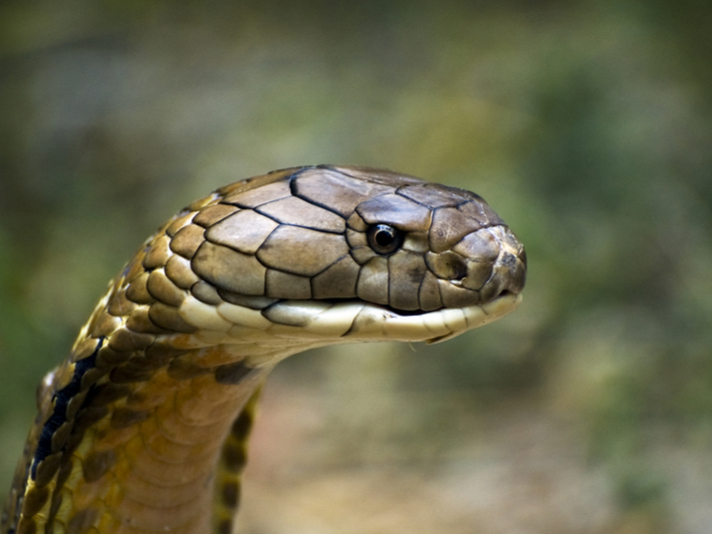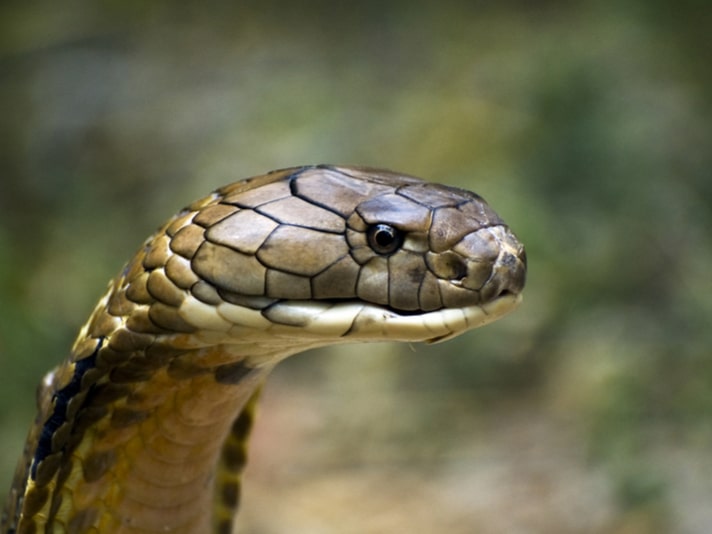The king cobra is the longest venomous snake in the world.
The king cobra (Ophiophagus hannah) is probably the most popular venomous snake in the world due in part to its massive size and the fact that it raises its head with its hood spread when it becomes agitated. The snake is also respected for its capability to eat other large snakes, including smaller pythons in its range, such as reticulated and Burmese pythons. Here are some facts about this most majestic and feared snake.

Heiko Kiera/Shutterstock
King cobras feed almost entirely on other snakes, though they are known to also eat rodents and lizards.
King Cobra Information
King Cobra and Reticulated Python Battle Caught on Video
- The king cobra is native to India and can be found throughout Southeast Asia, including Bangladesh, Bhutan, Burma, Cambodia, China, India, Indonesia, Laos, Nepal, the Philippine Islands, Singapore, Thailand, and Vietnam. It is not a member of the Naja genus, which all other cobras are, but rather has its own genus, Ophiophagus, Greek for “snake eating.”
- The king cobra can grow to about 16-18 feet in length and is the world’s longest venomous snake. Most king cobras are around nine to 13 feet in length, depending on their locality. They can weigh between 20-28 lbs, again depending on locality.
- The king cobra habitat includes dense highland forests, open woods and pasturelands near bodies of water.
- King cobras feed almost entirely on other snakes, though they are known to also eat rodents and lizards.
- King cobra venom is highly toxic and the snake can deliver a considerable amount in a single bite, upwards of 200 to 500 mg of venom. The venom affects the central nervous system, which causes blurred vision, vertigo, drowsiness,and paralysis. It then causes the collapse of the cardiovascular system and eventually respiratory failure. Immediate medical treatment is essential to enhance survival from a king cobra snakebite. It is said that death can come to a person bitten by a king cobra within 30 minutes, depending on the amount of venom delivered during the envenomation.
- There are now four king cobras in the Ophiophagus genus. In addition to Ophiophagus hannah, there are three subspecies: O. bungarus, O. kaalinga, O. salvatana.
While king cobras are feared in their native range, they are not responsible for the most deaths from a venomous snake. In fact, king cobras, like most other snakes, venomous and non-venomous, would prefer to stay away from humans, though human activity, such as deforestation and habitat destruction, has caused the interactions between venomous snakes and humans to grow. Other venomous snakes, such as the black mamba, are said by some to kill more people each year than the king of all venomous snakes.
John B. Virata keeps a western hognose snake, a ball python, two corn snakes, a king snake, and two crested geckos. His first snake, a California kingsnake, was purchased for $5. His first pet reptile was a green anole that arrived in a small box via mail order.


